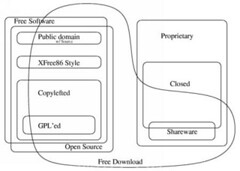Interesting LOMI seminar, we talked about open content. The confusion that it creates with people makes me think a bit like talking about FOSS with people some years back - everyone talked about open source software, but they mixed all the terms and everyone had a different idea in their heads; while some meant using stuff like Mozilla on Windows, others were musing about how it is so difficult because running Linux is so dam hard.
I love the graph from Chao-Kuei that clearly puts things in places. I want to see something like this for open content, too. We have to elaborate on the concept of open content and allow it to expand to cover different variations; what happens when the content is of public domain, what can be done when Creative Commons are used, etc.
Open content made available under Creative Commons license, for example,
might allow you to access it and use it, but not to make any derivative
works. That means you can't rip, mix and mash it the way you would like,
let alone release it out to anyone else. Having content under CC pretty
much, though, goes under the understanding of open content. The "source
code" might be made available for reviewing, but not for modifications!
The same availability of source code would suit for the cases of "freeware" content, the free stuff that is made available by publishers, for instance, but can't be ripped, not can't be modified, as no source code is made available. This is kind of "read only" content that can be very valuable, however, has no re-use aspect for modifications and re-distribution. Someone mentioned in the LOMI seminar that free/shareware never made it big, but it does have its marketing value. And that is the stuff that publishers are eager to give away for free, however there is no way a user can play around ripping and mashing it. So, defining what is free/shareware of open content would be useful.
Also, it should be addressed whether there can be open content that is
commercial in the same way that there is commercial open source
software. Some might be interested in developing products and services
around that idea. Hec, I want to see someone making money of WikiPedia! Thus, to define open content one should not use the price as an identifier. Rather, if commercialisation of open content is
allowed, a better starting point for the definition of open content
should better be, for instance, proprietary or non-proprietary content?
In the LOMI seminar we also talked about open content and tried to define it through three different degrees: Open for access; open for modification and re-distribution; open for ....I cant remember. As open source software, most participants agreed that it is important to allow modification and re-distribution. However important that is, and however important the FSF thinks it is, for the average user like me and my mom, it is not that important. I don't have any knowledge to modify the code nor do any modifications, I just want stuff that works. That why for me "access" is important! If I can't have it, I can't use it.
Rambling thoughts, by no means written in stone! I'm very willing to work on defining open content by working on its concept based on Chao-Kuei's graph. I like the idea of displaying a variety of choices and having something to show and give a common group for discussion.
Subscribe to:
Post Comments (Atom)


No comments:
Post a Comment